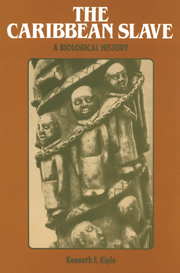Book contents
- Frontmatter
- Contents
- List of Tables
- Preface
- Acknowledgments
- Part I Background and Biology
- Part II Diet, Disease, and Demography
- Introduction
- 4 The Middle Passage and Malnutrition
- 5 Plantation Nutrition
- 6 Malnutrition: Morbidity and Mortality
- 7 Slave Demography
- 8 Slave Infant and Child Mortality
- 9 Black Diseases and White Medicine
- Part III Pathogens and Politics
- Notes
- Bibliographic Essay
- Index
6 - Malnutrition: Morbidity and Mortality
Published online by Cambridge University Press: 19 October 2009
- Frontmatter
- Contents
- List of Tables
- Preface
- Acknowledgments
- Part I Background and Biology
- Part II Diet, Disease, and Demography
- Introduction
- 4 The Middle Passage and Malnutrition
- 5 Plantation Nutrition
- 6 Malnutrition: Morbidity and Mortality
- 7 Slave Demography
- 8 Slave Infant and Child Mortality
- 9 Black Diseases and White Medicine
- Part III Pathogens and Politics
- Notes
- Bibliographic Essay
- Index
Summary
It is evident that the Negro system is materially different from ours. It could not have escaped observation how diseases differ in their respective colours of white and black.
John Williamson (1817)Plantation-America offers a magnificent laboratory for the comparative approach.
Charles Wagley (I960)As the preceding chapter indicated, if Caribbean slaves had not consumed a fairly wide variety of supplemental foodstuffs, their basic diets (despite their ideal nature in terms of planter claims) would have provoked serious nutritional deficiencies. Moreover, the nutritional “analysis,” which pointed up the slaves' inability to derive (and metabolize) adequate amounts of most of the chief nutrients was performed on an “ideal” diet during “ideal” times. Wars, economic circumstances, hurricanes, droughts, and outright famine increased the likelihood that the diet would frequently lack important components.
The result should have been widespread diseases of nutritional nature. But deficiencies pointed up by theoretical nutritional analysis require confirmation in the form of actual nutritional ailments. This chapter represents an effort to search out those ailments and match suspected deficiencies with the diseases they create.
Vitamin A Deficiency and Night Blindness
Table 2 pronounced Caribbean slaves generally vitamin A deficient because of a low yield from their basic foodstuffs. Those consuming rancid fish should have been dangerously low in vitamin A because of the destructive effect of rancidity on the fat-soluble vitamins.
Vitamin A deficiency can produce a variety of symptoms such as rough skin, skin blemishes, and even a loss of a sense of smell, but by far the easiest symptom to discern in the medical literature on Caribbean slaves is eye problems.
- Type
- Chapter
- Information
- The Caribbean SlaveA Biological History, pp. 89 - 103Publisher: Cambridge University PressPrint publication year: 1985



